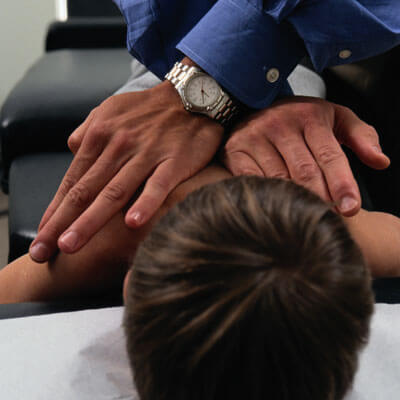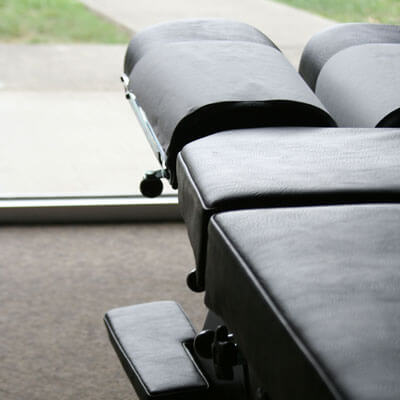Our Techniques

The Diversified Technique is one of the most common types of adjustments performed by chiropractors, according to the American Chiropractic Association.
Before performing the technique, our doctors do an extensive analysis of your spine. In order to gather as much information as possible, we generally collect a detailed case history from you and take x-rays of your back and neck.
Just prior to administering adjustments, we may perform motion palpation, in which we examine the spinal joints as you turn and bend. We’ll also often check your legs to uncover imbalances in the neck, mid-back or lower spine.
The Adjustment
If the loss of motion of one or more spinal vertebra is identified, a high-velocity, low-amplitude thrust is administered. This adjustment aims to restore movement and alignment to your spine and joints. The direction, speed, depth, and angle that are used in the Diversified Technique are highly precise and very safe. The Technique is perfected through years of experience and practice as well as a thorough understanding of spinal mechanics. The energy delivered during the thrust may produce a slight “popping” sound from the shifting of gas and fluids within the joint. This sound may be interesting, but is not indicative of the effectiveness of the adjustment.
While improving spinal biomechanics can reduce nervous system interference, virtually all joints of the body can be adjusted to help restore proper range of motion. This technique is so fundamental to chiropractic care that it’s the principal technique taught by a number of American chiropractic colleges.
How the Diversified Technique Works
Like other chiropractic techniques, the Diversified Technique works by restoring optimal function to your joints. If a joint is not functioning as it should, it affects all surrounding joints and tissues because they have to work to compensate for the limited range of motion and diminished performance of the affected joint.
Within joints are joint receptors that are capable of detecting any kind of mechanical changes. They essentially act as sensors to protect the joint from over-extension and over-flexion, and they send pain signals when they detect that a joint is not functioning optimally. Chiropractic adjustments like the Diversified Technique restore optimal function to the joint, thereby eliminating pain and improving nervous system function.

The Thompson Technique, developed by Dr. J. Clay Thompson and patented in 1957, has evolved into a system of analyses and a means of adjusting the entire spine. The approach produces precise adjustments while maintaining high levels of patient comfort.
Terminal Point Table
The Thompson Technique would not be possible without the use of a terminal point table, a specially designed table that helps facilitate a full adjustment of the spine.
This “drop table” was designed for use with the Thompson Technique. Each section of the table corresponds to a section of the body, making it possible to isolate the cervical, dorsal, lumbar, or pelvic area. It works with gravity to allow the isolated spinal region to “give” more readily and more comfortably.
While the patient lies prone on the table, the Thompson Technique is performed using high-speed thrusts with minimal force. Compared to other chiropractic techniques, little force is needed when administering the Thompson Technique because of the momentum allowed by the dropping section of the table. That’s what makes this a gentle technique.
How the Thompson Technique Works
Early chiropractors noticed that vertebral subluxations would produce the appearance of one leg being shorter than the other. Using a protocol of comparing leg lengths while the patient turns his or her head helps us to determine whether the vertebral subluxation is in the upper, middle, or lower back.
Performing this analysis allows us to determine which area of your spine is affected so we isolate the correct section. Individual cushions or “drop pieces” located along the table’s surface support the entire length of your spine until the thrust is delivered. Then, the cushion underneath the section of your spine being adjusted gives way, which reduces the amount of energy and force required to adjust the vertebrae.Benefits You Can Expect From the Thompson Technique
- Better posture
- Improved strength
- Enhanced flexibility
- Less injury-prone
- Better quality of sleep and relaxation
- Relief of aches and pains
- Greater ability to deal with stress
- Improved overall health and vitality

Craniosacral therapy (CST) is a technique that works to balance the skull and the spine. Utilizing a gentle, light-touch approach, this type of therapy releases tensions deep in the body and central nervous system. Using therapeutic touch to influence the cranium and spine, CST works to restore the natural rhythmic flow of cerebrospinal fluid.
We accomplish this creating and holding a space that allows the body to naturally heal itself. With slight compression or distraction of the connective tissue, the body is able to release and unwind its holding patterns, allowing all the systems in your body to self-correct.
How CST is Performed
CST is performed with the patient on a comfortable table in a quiet, nurturing environment. The technique gently works to resolve the underlying problem, not just the symptom. Proper control of every cell and tissue of your body is affected by the bones of the skull and the tension on your spinal cord. When your body is free of overall tension, you are able to move and function at an optimal level.
CST has been shown to be beneficial for all age groups. It can be of great help to individuals suffering from pain, especially in the head, jaw, neck, shoulders, and back. Infants and young children have had relief of symptoms such as constipation, colic, bed-wetting, and sympathetic overdrive. Along with aiding in pain relief and stress relief, this technique has also been shown to improve coordination, self-control, and mental focus, while reducing anxiety and fatigue. CST can also help resolve sinus and allergy issues and can even help prepare a woman for childbirth. Because CST naturally restores the body’s imbalances, it is inherently tailored to the specific needs of each patient.

At Total Wellness of NJ, the Activator Method is one of our most popular “low-force” chiropractic techniques.
The Activator Method is a chiropractic technique used to treat back pain, neck pain, and headaches with a small handheld instrument.
We perform the Activator Method using the Activator Adjusting Instrument, which applies a precise gentle force to the spine. The instrument is designed to help restore optimal range of motion to target spinal vertebrae and joints.
The Activator Adjusting Instrument is a handheld spring-loaded tool that delivers a consistent low-force, high-speed thrust. Because it’s many times faster than adjustments delivered by hand, the body rarely tightens to resist, making adjustments comfortable and effective. It’s also helpful for adjusting elbows, wrists, knees, and other joints of the body.
You may be familiar with the more classic form of spinal manipulation called the high-velocity low-amplitude (HLVA) thrust. The Activator Method is now used as an alternative to HVLA.
Next to the Diversified Technique, also offered at Total Wellness of New Jersey, the Activator Method is one of the most commonly used and researched chiropractic techniques in the United States.
Here’s an overview of what you can expect when we use the Activator Method:
Activator Method: Initial Evaluation
The patient is initially placed lying face-down on a table and the doctor first determines whether one leg is shorter than the other one. The commonly observed short leg is a “functional” short leg-a sign of a neurological and/or biomechanical involvement that causes imbalance in the body. After we achieve initial balancing and lumbopelvic stabilization biomechanically and neurologically, we can utilize an isolation test. This series of analyses begins with the lower back and progresses toward the head with tests for each vertebral segment available. We also use isolation tests for the extremities as well.
This time-tested protocol tells us if vertebral subluxations exist and at what locations. It also helps us determine when to adjust and when not to adjust.
Activator Method: The Procedure
Speed is key to the Activator instrument’s ability to restore proper mobility in the spine. The instrument is so quick that the body’s muscles don’t have time to tense up in response, which makes treatment more effective and successful.
Also key to Activator Method’s effectiveness is the precision of the Activator instrument. Since the force is applied locally to the affected joint, it does not add any additional torque or bending movement to the joint.
Essentially, like all other chiropractic techniques, the Activator Method works by restoring optimal function to your joints. Your body requires optimal joint function. If a joint is not functioning as it should, it affects all surrounding joints and tissues, because they have to work to compensate for the limited range of motion in the affected joint. By restoring proper spinal mobility, we can achieve optimal function and pain relief.
After we complete the adjustment, we’ll conduct follow-up visits to monitor its effectiveness.
Activator Method: The Follow-Up
After your adjustment, we retest to ensure that we’ve produced changes. Testing afterwards helps us deliver high-quality care and leads to higher levels of patient satisfaction.

The Webster technique is a specific chiropractic analysis and diversified adjustment. The goal of the adjustment is to reduce the effects of sacral subluxation and sacroiliac joint dysfunction. In doing so, neuro-biomechanical function in the pelvis is improved. This technique is particularly helpful for pregnant women. When the proper mechanics of the pelvis are restored, the baby has more room to move into the optimal position for birth. This, in turn, can allow for fewer interventions during childbirth, thus facilitating a safer and more natural delivery.
Benefits of the Webster Technique
You may have heard of the hormone “relaxin,” which is produced by a pregnant woman in order to prepare her body for birth. As the name suggests, relaxin causes the ligaments to loosen, especially those in the pelvic area, which allows a woman’s body to accommodate a growing baby and its eventual birth.
Unfortunately, this hormone can also cause the spine and pelvis to relax in misaligned positions. This, in combination with a woman’s pelvis-forward posture (an inevitable side effect of a growing belly), can make mom very uncomfortable and prevent baby from freely turning as he or she needs to.
It’s important to note that no chiropractor is trained to “turn a baby.” This is an obstetric technique that no chiropractor should attempt. However, by restoring the optimal function of the spine and pelvis, we are able to create conditions that may enable a baby to turn into ideal birth position all on his or her own. Prenatal chiropractic care has also been shown to lessen the chances that a baby will experience dystocia when exiting the birth canal. It also lessens the chances that birthing interventions, such as vacuums or forceps, will be needed.
How the Webster Technique is Performed
We use a table outfitted with special pillows in order to accommodate a pregnant woman comfortably. We’ll ask you to lie face-down the table while we gently perform adjustments on the sacral ligaments and structure. If you can comfortably lie on your back for a brief period, we can also release the uterine ligaments and anterior pelvic structures if needed. While we take great care to assure each and every patient is comfortable, we are especially aware of your needs and comfort as a pregnant woman. The Webster technique is extremely safe, gentle, and effective, and we never apply any direct external force to your baby.
When to Seek Chiropractic Care as a Pregnant Woman
Chiropractic care works best when give it time to do its work. Ideally, you should receive regular chiropractic care throughout your pregnancy to prepare your body for the best possible birthing experience. We recommend you see us in your first trimester to be evaluated and make a customized plan for optimal care. This plan will be based on your body mechanics, as well as any concerns, complaints, misalignments, and/or previous birth history. However, if you aren’t referred to a chiropractor until late in your pregnancy because, for example, your baby is breech or because you are experiencing a lot of pain and discomfort, you should absolutely still seek care.
According to the American Pregnancy Association, “all chiropractors are trained to work with women who are pregnant. Investing in the fertility and pregnancy wellness of women who are pregnant or trying to conceive is a routine care for most chiropractors.” We take this a step further to ensure we are providing the absolute best and safest possible care for our pregnant patients by maintaining an active Webster certification.
Learn More
Drs Bret and Tami offer a variety of techniques to help patients relieve pain and achieve wellness. Call Total Wellness of NJ today to schedule an appointment.
CONTACT US »
